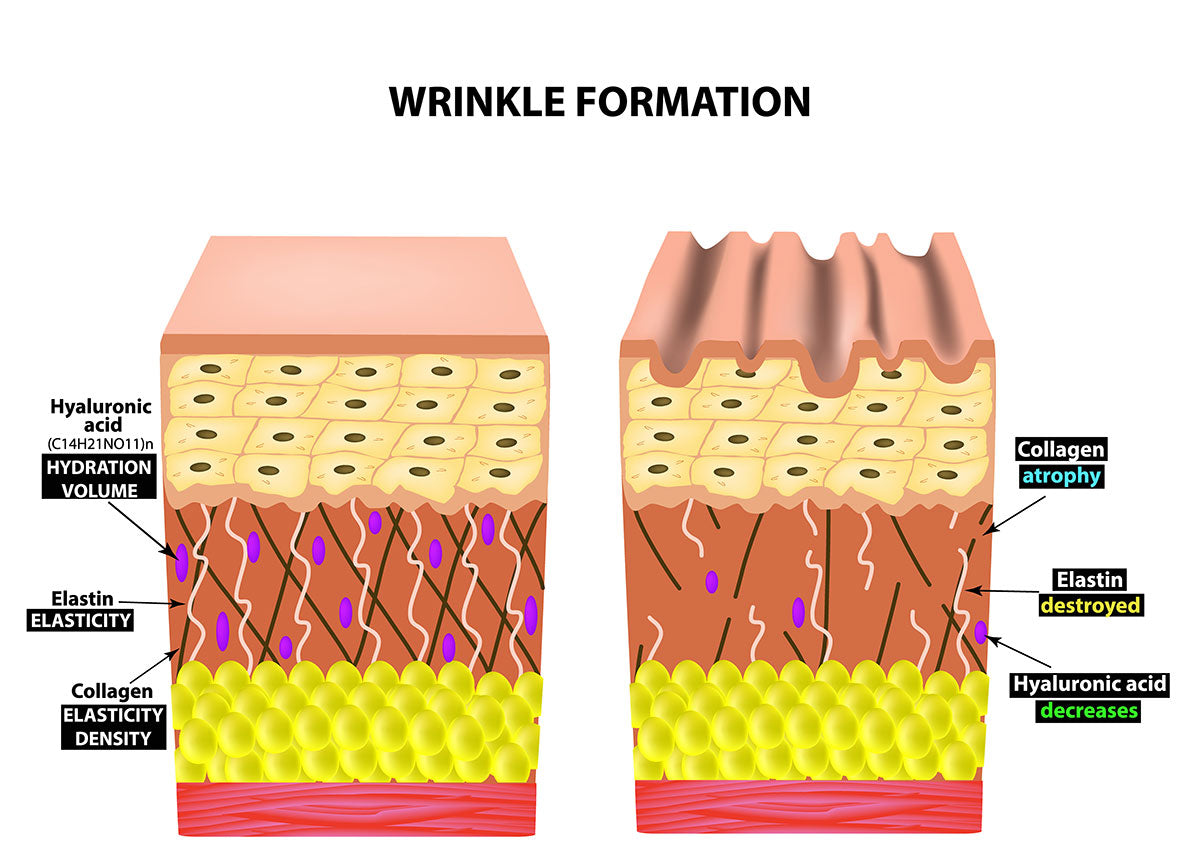Within the beauty industry there are certain facts that can’t be disputed. For instance, Vitamin C can brighten dark spots, and hyaluronic acid moisturizes. As it turns out, there’s a lot about hyaluronic acid you need to be more aware of—like the difference between it and sodium hyaluronate. Or how that hyaluronic acid has been known for years now to be the modern day “holy grail’ for wrinkle-free, youthful hydration.
To help decipher the skin wonders of hyaluronic acid, it’s vital to understand the surprising truth about this highly touted ingredient.
What Is Hyaluronic acid?
For starters, hyaluronic acid is a molecule that is naturally found in your skin as well as the connective tissue in your body. It is a naturally occurring polysaccharide found in the human body that acts as a cushioning and lubrication agent for your joints, nerves, hair, skin, and eyes.
Hyaluronic acid's main uses and benefits are keeping skin moist and lubricated, therefore it is a super star at alleviating dry skin.
Hyaluronic acid is a moisture binder, which means that it will attach itself to the water in the cells making them 'plump.' This ingredient that appears first in many aging creams and serums is strikingly powerful and therefore works as an incredibly powerful moisturizer. Hyaluronic acid can draw moisture from air and keep your skin moist, holding almost 1000 times its own weight in water, so it is not only a moisturizer, it has the ability to hold extra moisture as well.
You can even take hyaluronic acid as a supplement, but it’s recommended to consult a doctor before you do so. Normally, it's most popularly used as a topical treatment like a serum or gel lotion, but it's also used for filler injections.
The benefits of Hyaluronic acid
The reason the beauty industry loves it so much lies in its seemingly magical ability to retain moisture. Studies have proven that hyaluronic acid is amazingly good at bonding with water molecules, making it a key factor in retaining skin moisture. Lack of moisture is one of the main culprits of aging skin, which is why this ingredient—which attracts moisture to your skin—is a must-have when it comes to repairing your skin’s moisture barrier.
Following are some essential benefits of Hyaluronic acid:
- Retains moisture - Hyaluronic acid helps replenish and hold cell moisture, leading to hydrated, plump skin.
- Reduces the appearance of wrinkles - Since dehydrated skin is one of the main causes of wrinkles, hyaluronic acid replenishes lost moisture and helps reduce the appearance of any fine lines.
- Safe option for filler - Since hyaluronic acid's composition is so closely-related to substances in our bodies, it works well as a filler that doesn't cause major irritation. It can also add volume to areas like the lips and cheeks, which naturally lose volume over time.
- Fast absorbing - Unlike some skincare products, hyaluronic acid quickly absorbs into the skin, meaning you lose less product.
- Non-irritating - For the most part, hyaluronic acid is non-irritating and safe for use with all skin types.
- Short-Term Injectable - When used as a filler, hyaluronic acid lasts for around a year. It dissolves naturally, meaning you don't have to go in to have the filler removed by a doctor.
- Multiple forms of use - Since you can use hyaluronic acid topically, have it injected, or take it as a supplement, there are plenty of options for how and when you use it.
- Available over-the-counter - Unlike some super skincare ingredients, hyaluronic acid products are available in most beauty and drugstores.
Potential side effects of Hyaluronic acid
Generally, there aren't any known side effects of hyaluronic acid—at least, the topical versions. But, hyaluronic acid is often used as a filler, and therefore can cause side effects. There may be swelling, but since hyaluronic acid is so closely-related to natural substances already in the body, most reactions are from the injection itself, not hyaluronic acid.
If you choose to ingest hyaluronic acid, it is proven to reduce the appearance of wrinkles and improve the overall plumpness of skin. Plus, most people find that the supplement doesn't have side effects.
How to use and apply Hyaluronic acid
For hyaluronic acid to really penetrate the skin’s surface when applied topically, it actually has to be bioengineered to have a much lower molecular weight. Most chemists are able to do so while still maintaining the original hydrating benefits. In fact, in-office treatments can help hyaluronic acid penetrate more deeply into the skin.
When combined with a Hydra Facial or SaltFacial, for example, serum is infused into the skin for a better or more effective penetration of the smaller molecules than application to the top of the epidermis alone. If you’re looking to use hyaluronic acid as a filler, it's obviously best to seek out a doctor's opinion first. Much like topical hyaluronic acid, the injectable kind also mimics materials already present in our bodies.
Injecting a hyaluronic acid filler in a gel form through a syringe into the various areas of your face, eyes, or other areas is accepted and remains with the body and is used like your other cells as a 'partner' filling, volumizing that area and creating an overall more youthful look.
Conclusion
When used in skin care products like creams and serums, hyaluronic acid brings moisture to the surface of your skin. Because of its ability to draw and hold water, it can be used as a humectant in your skin care regimen, as it continually keeps skin moisturized throughout the day. This alone gives your skin and wellness practice something to celebrate.





